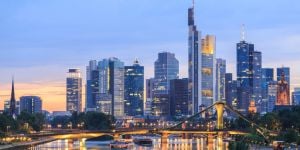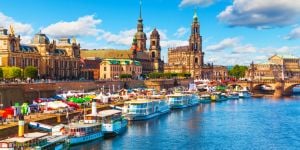
Stretching over some 328km² in the Saxony region, Dresden is one of Germany's largest cities by area and the third-most populous city in East Germany, with more than 592,000 inhabitants. Due to its forward-looking agenda, which focuses on technology and innovation and smart urban development and balances well-being and progress, Dresden has been attracting thousands of expats over the years.
As of 2023, about 16 percent of all residents have a migration background. Also, the city is very popular among international students thanks to its world-class higher education institutions, which offer state-of-the-art facilities, talented professors and tutors, and employment prospects for graduates. Dresden's priority is to ensure that all residents have access to income, quality education, health services, and affordable housing — and all this is accessed in a sustainable and environmentally friendly way. Hence, different sectors (i.e., business, science, politics, and administration) collaborate along with citizens' voices to improve the future of Dresden and the quality of life of its citizens.
Reasons to move to Dresden
In 2020, Dresden adopted the Cultural Development Plan, a four-year collaboration between experts, academics, and citizens to promote social cohesion, gender equality, cultural participation, diversity, and inclusion in Dresden. For example, there's a plan for each neighborhood in Dresden to have its own cultural center where cultural education and expression through art will be promoted. Also, the Integrated Urban Development Concept “Future Dresden 2025” envisions Dresden as a hub of innovation and science. Dresden acknowledges the importance of art and humanities, on the one hand, and respects the valuable contributions of technological advancement, on the other hand, realizing that the well-being of its population is founded on both. These make up the key foundations for Dresden's bid for the “European Capital of Culture 2025”.
Dresden has a vivid start-up market with numerous success stories from which to draw. Once a year, Dresden organizes the High-tech Venture Days, where 40 selected European entrepreneurs have the opportunity to present their ideas to around 160 international investors and mentors and expand their network. Also, Dresden is home to the Silicon Saxony high-tech network, which connects academia, research institutes, public and private institutions, manufacturers, and suppliers for peer-to-peer learning and knowledge sharing in the tech industry. In Dresden, there are many thriving businesses in the sectors of 5G technology, artificial intelligence, robotics, and smart healthcare, thanks to the robust presence of research institutions such as the Technical University of Dresden, the University of Applied Sciences (HTW Dresden), and the Helmholtz-Zentrum Dresden-Rossendorf. The diversity of industries in Dresden is crucial for the city's sustainable economic development.
Dresden is a child-friendly city, ideal for expat families. Every neighborhood has playgrounds where children can play carefree, and parents can have peace of mind as they play in specially designed, safe environments. The entire city has no less than 839 open spaces for children, which are maintained frequently to ensure high safety standards. Also, the city has 632 urban green spaces and parks, which are maintained thanks to citizens' financial support and participation in cleaning and gardening. Some of the most popular parks in Dresden are Bürgerwiese and Blüherpark in Dresden's old town, as well as Rosengarten and Staudengarten on the banks of the Elbe River in Neustadt. Other parks are Alaunplatz, Beutlerpark, Leutewitzer Volkspark, Mageburger Straße, and Gehestraße.
Last but not least, Dresden has a well-developed transportation network made of motorways, highways, smart traffic management systems, and eco-friendly means of transport. Within Dresden, residents can travel by train, bus, tram, and ferry.
Good to know:
If you are looking for partners or work in Dresden, you can search Dresden's companies' online database at the Wirtschaftsförderung Sachsen GmbH (i.e., Saxony Economic Development Agency). The search can be done on the basis of region, industry, product, or name of company.
Useful links:
Helmholtz-Zentrum Dresden-Rossendorf
Popular neighborhoods in Dresden
Many historic buildings, such as the famous Frauenkirche church, the Zwinger palace, and Semperoper, have been restored during the past 20 years, turning Dresden into a popular tourist destination with various places of interest, among which the Elbe valley, which used to be on the UNESCO World Heritage list, but lost its title due to the construction of the four-lane bridge amid the site. Dresden has a long history as a royal residence and the capital of Saxony. It is also known for its Baroque and Rococo city center, most of which were destroyed during World War II. The city's reputation as an artistic and cultural center derives from art collections, cultural institutions, and historically significant monuments from different periods.
Dresden is divided into ten districts, namely Altstadt, Neustadt, Pieschen, Klotzsche, Loshcwitz, Blasewitz, Leuben, Prohlis, Plauen, and Cotta. These districts are, in turn, divided into several neighborhoods. Among these are Innere Altstadt, Friedrichstadt Albertstadt, Innere Neustadt, Wachwitz, and Gorbitz. Each of these districts and neighborhoods has its unique personality and attracts individuals with different lifestyles. Altstadt, Innere Neustadt, and Hellerau are popular with tourists due to their old architecture and ruins of archaeological value. For example, the historic Altstadt (the Inner Old Town) has undergone a massive reconstruction and development program following World War II. As a result of the almost complete destruction of housing in this district, the population size and density are still low. Altstadt has the highest density of hotels. Hotel chains such as Hilton, Kempinski, Seaside Hotel Group, and Steigenberger Hotel are located in the inner part of Alstadt.
Numerous restaurants and bars are located in the trendy pub area Weiße Gasse. The Innenstadt (city center) is also very popular for its boutiques, shopping malls, restaurants, and movie theatres. Shopping and nightlife lovers will be delighted there.
Äußere Neustadt (also known as Antonstadt) is one of Dresden's trendiest and liveliest neighborhoods and has plenty of restaurants, bars, clubs, and cafes. It is a vibrant neighborhood with plenty of fun and music events. The Gründerzeit buildings were less affected by the destruction of WWII and have been part of a flourishing alternative cultural area since the division of Germany.
Innere Neustadt, which has also undergone a redevelopment program, hosts many posh shops and restaurants, as well as modern and luxurious houses and apartments. It is mostly surrounded by the Elbe River, whose waterfront offers many parks and beer gardens. One of the best streets to see is Königstraße, which provides the ideal shopping experience mixed with the magnificent, predominantly Baroque architecture. Loschwitz, Südvorstadt, and Weisser are other popular neighborhoods, with bars and cafés, dormitories, and university campuses for students.
Good to know:
Neighborhood assistants are individuals who are willing to support senior people with reduced mobility. The concept of neighborhood assistants is to promote the community spirit across generations and fight loneliness.
Useful link:
Nebenan: Find out about your neighborhood and connect with your neighbors.
Rent prices in Dresden
Housing in Dresden is relatively affordable. Thus, you may rent a single-bedroom apartment in the city center for about 750 euros and a three-bedroom apartment for 1,300 euros. Of course, the rental costs drop significantly when you move outside the center. A three-bedroom place in the outskirts is, on average, 800 euros, depending on appliances, year of construction, and length of the contract. If you have doubts about the asked price for a place, you can check the Dresden Rent Index and compare the rent of your place with average rent prices in the same area for a similar kind of property (based on size, construction year, location, and special features). The index contributes to a transparent real estate market in Dresden, as every house owner who wishes to increase the rent of their property has to provide all required information to the index. According to the Saxon Capping Limit Ordinance, which is in force in Dresden, the rent cannot increase by more than 15 percent within 3 years.
How to find accommodation in Dresden
The internet is undoubtedly a helpful tool during your housing search in Dresden. Start by visiting general and specialized real estate websites and even classified ads in local newspapers, such as the Sächsische Zeitung. If you are already residing in the city, you can also consider registering with a real estate agency to get more chances to find accommodation that suits your criteria. However, keep in mind that real estate agents mean additional costs on top of the rent and deposit you must pay to the house owner.
Once you have made the first contact with the house owner, you should be ready to provide a copy of your passport, proof of your income (i.e., employment contract or last month's payslip), and a Selbstauskunft, which is a questionnaire to provide information regarding your personal details, current income, family status, etc. Before signing the contract, make sure that information such as whether the rent includes all bills or they have to be paid separately (i.e., Kaltmiete) is clear on paper.
Useful links:
Dresdner magazine
Housing societies: STESAD, Wohnen in Dresden, Saxon Housing, and WG Aufbau.
We do our best to provide accurate and up to date information. However, if you have noticed any inaccuracies in this article, please let us know in the comments section below.








